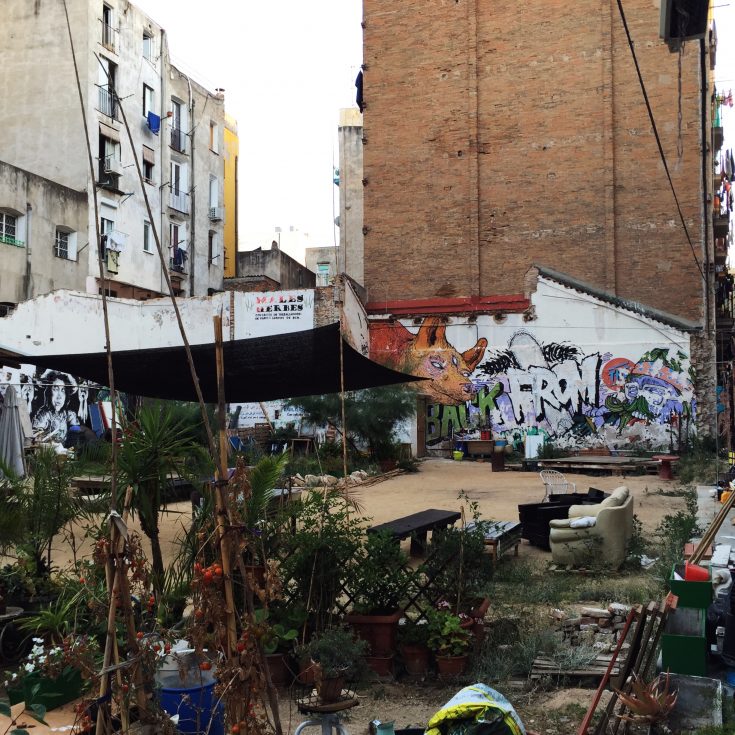A Fearless Garden of Defiance in Barcelona Spain
I have seen many gardens in my travels but only a few really stick in my mind. Sometimes it’s the planting or the weather or some aspect of the design that makes a place memorable. But sometimes it is something else entirely.
I happened upon the intersection of Carrer de l’Aurora and Carrer de la Riereta in the Raval neighborhood of Barcelona when I visited in 2016. At the time, I wasn’t headed anywhere in particular and I wasn’t expecting to find a garden. I was wandering the less touristy Raval neighborhood in search of a Barcelona a little more authentic and a little less touristy than many other areas of the city.

Needing water, I stopped at the bodega on the corner. As I came out, there was a moment with this mural and this soccer girl playing in the street that struck me as an interesting snap for color and composition. Plus, I’d just accepted a position to coach soccer to girls her age, and am always happy to see women playing soccer around the world.
Intrigued by the mural, I followed the trail of paint around to the other side of the wall and discovered a garden. While it felt like public space, it was also a place where I wasn’t sure I was actually welcome. The walls of all the surrounding buildings that made up the container of the garden were covered with fascinating murals. And the place reeked of stories that I could not fully grasp — but could only sense. I didn’t really know anything about what I was seeing — only that it was captivating.
…
The quote on the wall is in Spanish and it translates to “They wanted to bury us. They didn’t know that we were seeds”. It was written by a Greek poet named Dinos Christianopoulos who was a lyrical voice for the homosexual community in the mid 20th century. In figuring out the translation, I was fascinated to read how his words were altered and became a rallying cry for the Mexican Zapatista movement in the 70’s.
Thinking that I understood what the words meant and considering myself a responsible modern day writer — how could I not post the shot on instagram?
Social media is sometimes magical. A follower of my instagram saw my picture and shared with me the rest of the story — which I will share with you.
…
Late on the evening of October 5th, 2013, there was a fight on this street corner. It caused a commotion that drew the attention of many onlooking neighbors who witnessed the ultimate crime from their windows. The incident that took place was recorded on many cell phones from many angles. Juan Andrés Benitez, a local man known by many, was openly murdered by the police in what is widely condemned as a case of blatant police brutality. Despite the many videos and witnesses, there has been no justice for the crime.

The garden has been given the unofficial name of Plaça de Juan Andrés Benitez by the people who live there. Immediately after the murder, the people in the neighborhood, along with city street artists, organized the small quiet garden in memory of Juan Andrés. It is about a quarter of a city block and people continue to gather there to play music, talk and spend time together. On the 5th of every month (since October of 2013), there are events to remind people and continue to raise awareness of ongoing police brutality and impunity in Spain and around the world.

The murals are the highlight of the garden and are what caught my initial attention. But it was only weeks later that I could fully understand some of their messages and meaning. This part of the mural represents the people and nature fighting together against the government, police, corporations, banks, tourism, industry and pollution.
The images of the blindfolded man and the silenced woman and the quote “They wanted to bury us. They didn’t know that we were seeds” are part of a set of works dedicated to the 2014 Iguala mass kidnapping of 43 male students of Ayotzinapa Rural Teachers College. It is another case of horrific police brutality and corruption that took place in Mexico.
It strikes me how unmistakable it was that this place carried great weight and importance. Perhaps if there had been other people in the garden that day, I’d have noticed other things, but in mood, I found this not so different that visiting other monuments to the fallen. I find it interesting to recall that my companions and I spoke only in whisper tones. Why? I don’t know what we sensed that made this seem appropriate. I’d like to visit again, knowing what I know now, and study the art and imagery of this unexpected find.
The story of the garden came to me via @msjoce28 and @orange.wine
If you want to visit it, go to the crossing of Carrer de l’Aurora and Carrer de la Riereta in the Raval.
Please also remember to be respectful.